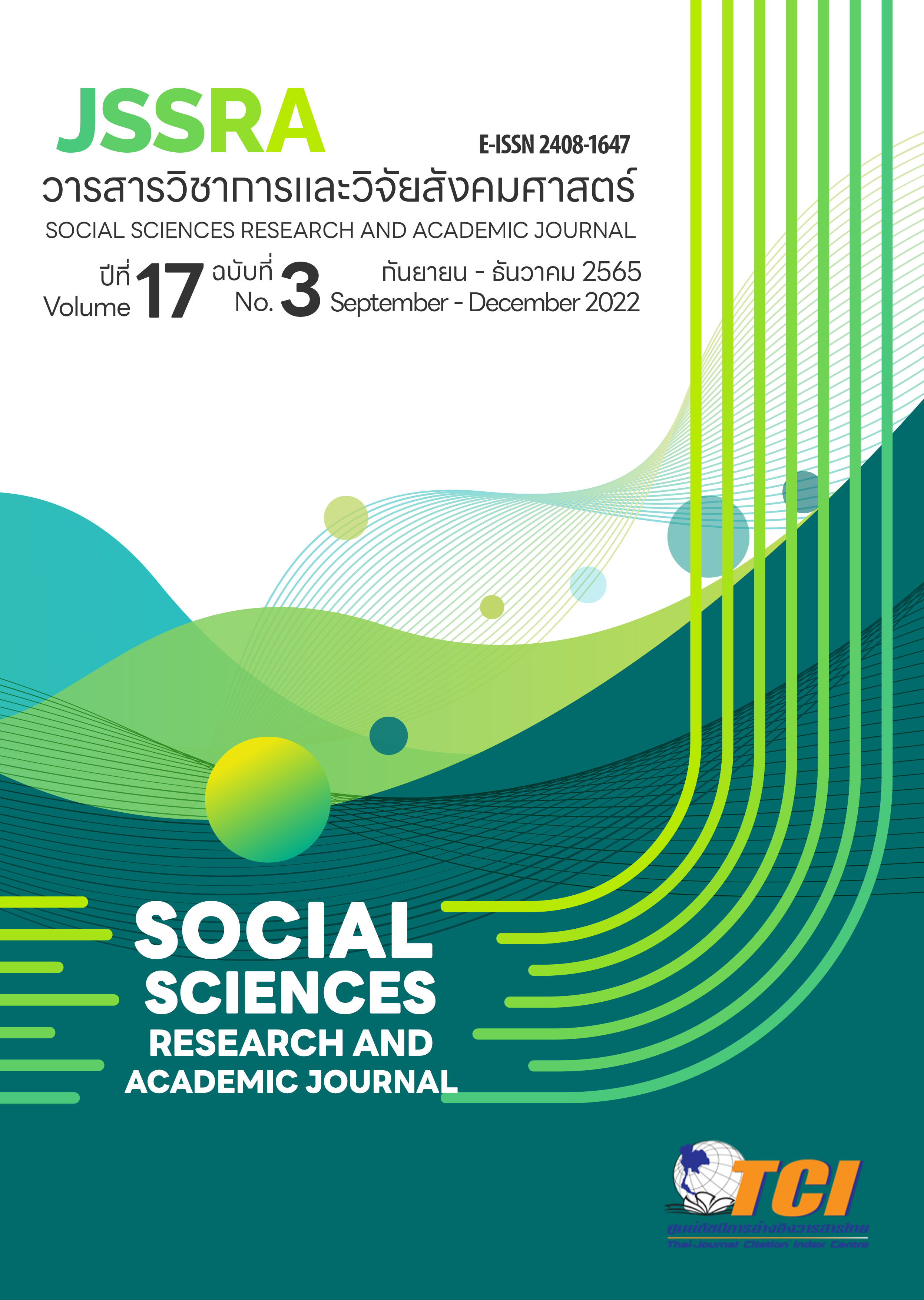ภาวะผู้นำทางวิชาการของผู้บริหารสถานศึกษากับการสร้างความเชื่อประสิทธิภาพ ของกลุ่ม : อิทธิพลปฏิสัมพันธ์ของการเป็นครูที่ปรึกษา Principal instructional leadership for building collective efficacy: The interaction effect of homeroom teacher
Main Article Content
บทคัดย่อ
การวิจัยครั้งนี้ มีวัตถุประสงค์หลัก 2 ประการ ได้แก่ 1) เพื่อวิเคราะห์อิทธิพลปฏิสัมพันธ์ระหว่างการเป็นครูที่ปรึกษาและภาวะผู้นำทางวิชาการของผู้บริหารสถานศึกษาที่มีต่อความเชื่อประสิทธิภาพของกลุ่ม 2) เพื่อวิเคราะห์อิทธิพลปฏิสัมพันธ์ระหว่างการเป็นครูที่ปรึกษาและองค์ประกอบภายในภาวะผู้นำทางวิชาการที่มีต่อความเชื่อประสิทธิภาพของกลุ่ม ตัวอย่างของการวิจัยเป็นครูโรงเรียนเอกชนแห่งหนึ่งในจังหวัดนครสวรรค์ จำนวน 120 คน เป็นครูที่ปรึกษาจำนวน 71 คน และไม่ใช่ครูที่ปรึกษา 49 คน ได้มาด้วยวิธีสุ่มอย่างง่าย เครื่องมือที่ใช้ เป็นแบบสอบถาม มีลักษณะเป็นมาตรประมาณค่า 5 ระดับ ตรวจสอบคุณภาพเครื่องมือด้านความตรงและความเที่ยง มีค่าความสอดคล้องภายในของแบบวัดภาวะผู้นำทางวิชาการของผู้บริหารสถานศึกษา และความเชื่อประสิทธิภาพของกลุ่ม .87 และ .90 ตามลำดับ ผลการวิจัยพบว่า อิทธิพลปฏิสัมพันธ์ระหว่างการเป็นครูที่ปรึกษาและภาวะผู้นำทางวิชาการของผู้บริหารสถานศึกษาส่งผลต่อความเชื่อประสิทธิภาพของกลุ่มอย่างมีนัยสำคัญทางสถิติที่ .05 (β = .40) สามารถอธิบายความแปรปรวนรวมคิดเป็นร้อยละ 15 และ เมื่อเปรียบเทียบค่าอิทธิพลปฏิสัมพันธ์ของการเป็นครูที่ปรึกษาร่วมกับองค์ประกอบของภาวะผู้นำทางวิชาการ จะพบว่า ปฏิสัมพันธ์ร่วมด้านการกำหนดพันธกิจ มีค่าสูงสุด (β = .38) รองลงมา คือ ด้านการจัดการด้านการเรียนการสอน (β = .34) อธิบายความแปรปรวนได้เพิ่มขึ้นร้อยละ 6 และ 5 ตามลำดับ ทั้งนี้ไม่พบปฏิสัมพันธ์ร่วมระหว่างการเป็นครูที่ปรึกษากับการสร้างบรรยากาศทางวิชาการ ข้อค้นพบที่ได้ ทำให้เข้าใจบทบาทภาวะผู้นำทางวิชาการของผู้บริหารสถานศึกษาในการส่งเสริมความเชื่อประสิทธิภาพของกลุ่มให้กับครูในโรงเรียน งานวิจัยนี้ยังพบว่า การเป็นครูที่ปรึกษาแทรกแซงอิทธิพลของภาวะผู้นำทางวิชาการที่มีต่อทัศนคติของครูที่มีต่อทีมงาน ทำให้ได้ข้อเสนอแนะสำคัญ 3 ประการ คือ 1) ควรกำหนดบทบาทหน้าที่และความรับผิดชอบของครูที่ปรึกษาที่ชัดเจน และ 2) สร้าง “ครูที่ปรึกษามืออาชีพ” และ 3) เชื่อมความสัมพันธ์ระหว่างผู้บริหารและครูที่ปรึกษาเพื่อสร้างการทำงานเป็นทีมที่ช่วยลดช่องว่างระหว่างกัน
This study had two main objectives. First, it analyzed the interaction effect of being homeroom teacher on the association between principal instructional leadership on collective efficacy and, second, it analyzed the interaction effect of being homeroom teacher on the relationship between three dimensions of principal instructional leadership and collective efficacy. The sample included 120 private school teachers in Nakhon Sawan obtained through a random sampling method. Out of 120, 71 were homeroom teachers, while the rest were not. A 5-point Likert scale questionnaire was used and tested for both validity and reliability. The internal consistency were .87 and .90 for principal instructional leadership and collective efficacy, respectively. The study found that being homeroom teacher had a significant interaction effect on the relationship between principal instructional leadership construct and collective teacher efficacy at a .05 significance level (β = .40). The percentage of variance explained by instructional leadership construct and the interaction terms were 15 percent. Moreover, a series of product terms between being homeroom teacher and three dimensions of instructional leadership were created and also tested for more interaction effects. The study found that two products terms such as being a homeroom teacher* defining the school mission (β = .38), and being a homeroom teacher*managing the instructional program (β = .34) had significant interaction effects on collective efficacy. The additional variance explained by the two interaction terms were 6 and 5 percent, respectively. These results enlightened the understanding of how school principal’s instructional leadership led to collective teacher efficacy. There were three main recommendations. First, homeroom teachers’ tasks and duties should be clearly defined. Second, school leaders with instructional leadership should find an effective way to nurture and develop “professional homeroom teachers”. Finally, a strong bond between the principal and homeroom teachers should be created through team building.
Article Details
เอกสารอ้างอิง
ข้อบังคับคุรุสภาว่าด้วยมาตรฐานวิชาชีพ พ.ศ. 2556. (2556, 4 ตุลาคม). ราชกิจจานุเบกษา. เล่ม 130 ตอนพิเศษ 130 ง. หน้า 65–71.
รัตนา แซ่เล้า, โทมัส ปาร์ค, วงอร พัวพันสวัสดิ์, ภูมิศรัณย์ ทองเลี่ยมนาค, ณัฎฐภรณ์ หลาวทอง, สุกรี นาคแย้ม และคนอื่น ๆ. (2564). จากความท้าทาย สู่คุณภาพการศึกษาของประเทศไทย: กฎระเบียบ การบริหารทรัพยากร และความเป็นผู้นำ. กรุงเทพฯ: มูลนิธิเอเชีย.
เสาวรส ยิ่งวรรณะ. (2555). บทบาทของความเชื่อประสิทธิภาพรวมกลุ่ม และในตนที่เป็นตัวแปรส่งผ่านระหว่างภาวะผู้นำการเปลี่ยนแปลงกับความผูกพันต่อองค์การของครู:การวิเคราะห์โมเดลสมการโครงสร้างพหุระดับ. วิทยานิพนธ์ครุศาสตรดุษฎีบัณฑิต (วิธีวิทยาการวิจัยการศึกษา), จุฬาลงกรณ์มหาวิทยาลัย, กรุงเทพ.
Bandura, A. (1997). Self-efficacy: The exercise of control. New York: Macmillan.
Brinson, D & Steiner, L. (2007). Building Collective Efficacy: How leaders inspire teachers to achieve. Center for Comprehensive School Reform and Improvement. DC: The center for comprehensive school reform and improvement. Retrieved December 31, 2021, from https://files.eric.ed.gov/fulltext/ED499254.pdf
ÇAlik, T., F. SezgİN, H. Kavgaci, and A. Ç. KilinÇ. (2012). Examination of Relationships between Instructional Leadership of School Principals and Self-Efficacy of Teachers and Collective Teacher Efficacy. Educational Sciences: Theory & Practice, 12(4), 2498–2504.
Cansoy, R., and H. Parlar. (2018). Examining the relationship between school principals’ instructional leadership behaviors, teacher self-efficacy, and collective teacher efficacy. International Journal of Educational Management, 32(4), 550–567.
Chou, H. W., Lin, Y. H., Chang, H. H., & Chuang, W. W. (2013). Transformational leadership and team performance: The mediating roles of cognitive trust and collective efficacy. Sage Open. 3(3), 1-10.
DeWitt, P. M. (2017). School climate: Leading with collective efficacy. Corwin Press.
Farina, M. (2019). The study of evaluating teacher perspectives of collective efficacy in the high school professional learning community. Doctoral dissertation, Florida Southern College, FL.
Ghimire, D., & Aljanaby, A. (2020). Agile practices in teaching and learning in teamwork: A conceptual framework. New Zealand Journal of Business & Technology, 18(2), 26-33.
Goddard, R. D., Hoy, W. K., & Hoy, A. W. (2000). Collective Teacher Efficacy: Its Meaning, Measure, and Impact on Student Achievement. American Educational Research Journal, 37, 479–507.
Goodman, S. F., & Turner, L. J. (2013). The design of teacher incentive pay and educational outcomes: Evidence from the New York City bonus program. Journal of Labor Economics, 31(2), 409–420.
Hair, J. F., Black, W.C., Babin, B.J., and Anderson, P.E. (2010). Multivariate Data Analysis. New York, NY: Pearson Education Limited.
Hallinger, P. (2010). Developing instructional leadership. In B. Davies; & M. Brundrett (Eds.), Devloping Successful Leadership: Studies in Educational Leadership (pp. 61–76): London: Springer.
Hallinger, P., & Murphy, J. (1985). Assessing the instructional management behavior of principals. The elementary school journal, 86(2), 217–247.
Hallinger, P., Gümüş, S., & Bellibaş, M. Ş. (2020). 'Are principals instructional leaders yet?' A science map of the knowledge base on instructional leadership, 1940–2018. Scientometrics, 122(3), 1629–1650.
Imberman, S. A., & Lovenheim, M. F. (2015). Incentive strength and teacher productivity: Evidence from a group-based teacher incentive pay system. Review of Economics and Statistics, 97(2), 364–386.
Kurz, T. B., & Knight, S. L. (2004). An exploration of the relationship among teacher efficacy, collective teacher efficacy, and goal consensus. Learning environments research, 7(2), 111–128.
Lyons, W. E., Thompson, S. A., & Timmons, V. (2016). ‘We are inclusive. We are a team. Let's just do it’: commitment, collective efficacy, and agency in four inclusive schools. International Journal of Inclusive Education, 20(8), 889–907.
Shamir, B., Arthur, M. B., & House, R. J. (1994). The rhetoric of charismatic leadership: A theoretical extension, a case study, and implications for research. The Leadership Quarterly, 5(1), 25–42.
Versland, T. M., & Erickson, J. L. (2017). Leading by example: A case study of the influence of principal self-efficacy on collective efficacy. Cogent Education, 4(1), 1286765.
ÜNVER, T. (2021). Teacher Professional Learning Community As A Predictor of Collective Teacher Efficacy. Akademik Platform Eğitim ve Değişim Dergisi, 4(1), 131–146.


